Physical Address
304 North Cardinal St.
Dorchester Center, MA 02124
Transvaginal ultrasound (TVU) for cervical assessment is one of the best techniques for predicting preterm birth (PTB).
A cervical length (CL) of less than 25 mm between 16 and 24 weeks' gestation is the most reliable threshold for an increased risk of PTB.
The shorter the cervix and the earlier in gestation the shortening occurs, the higher the risk of PTB.
TVU is the gold standard for ultrasound cervix measurements because a short cervix can be missed on transabdominal scans.
Appropriate technique is key to accurate TVU measurement of CL.
With a dynamic cervix, or in the presence of funneling, practitioners should report the shortest optimally imaged transvaginal ultrasound measurement of closed CL as the one single measurement to guide clinical decisions.
The same transvaginal CL has very different positive predictive values depending on the a priori individual patient characteristics.
The predictive value of sonographic CL determination in twins between 24 and 34 weeks' gestation is low.
Ultrasound assessment of the cervix during pregnancy has become an essential part of modern clinical care. Significant advances have been made in understanding the proper role of this sonographic screening test. In this chapter we will review the technique of transvaginal cervical assessment and discuss its expanding role in clinical practice.
In the 1970s, the first attempts at evaluating the cervix used transabdominal ultrasound (TAU). Unfortunately, this technique has relatively poor reliability and validity because of the following shortcomings: (1) the bladder often needs to be adequately filled to obtain a good image, resulting in elongation of the cervix and masking of any funneling of the internal os; (2) fetal parts can obscure the cervix, especially after 20 weeks; (3) the distance from the probe to the cervix results in degraded image quality; and (4) obesity and manual pressure interfere with the resulting image. Therefore, it is generally suggested that TAU should not be used for assessment of the cervix, even as a screening test, because its sensitivity for prediction of disease (e.g., increased risk for PTB) is unacceptably low (8%) in comparison to TVU. All randomized controlled trials (RCTs) that proved benefit with different treatments for a sonographically detected short cervix used TVU: vaginal progesterone, cerclage, and pessary. The sensitivity of TVU has been shown to be significantly higher than TAU in detecting a short cervix ( Table 18-1 ).
| Study * | GA, Week (Mean) | N (TVU CL < 25 mm) | Bladder | Blind | TAU Cutoff (mm) | TA Variation (Longer/Shorter) | Sensitivity | Need TVU (TAU Not Obtainable) |
|---|---|---|---|---|---|---|---|---|
| Saul et al, 2008 | 14-34 (22) | 191 (14) | Postvoid | Yes | ≤30 | Same | 100% | NA |
| Stone et al, 2010 | 18-20 | 203 | Postvoid | No | NA | Shorter | NA | NA |
| To et al, 2000 | 22-24 (23) | 149 | Prevoid | NA | NA | NA | NA | NA (51%) |
| Hernandez-Andrade et al, 2012 | 6-39 (24) | 220 (20) | Prevoid | Yes | ≤25 ≤30 |
Longer | 43% 57% |
NA |
| Friedman et al, 2013 | 18-24 (20.5) | 1217 (76) | Prevoid Postvoid |
No | ≤36 ≤36 |
Shorter | 96% 96% |
60% (6%) NA (17%) |
* These studies are listed in the references at the end of the chapter.
As can be seen from the studies described in Table 18-1 , it is still unclear if TAU is better done before or after voiding; only two studies report blind results. The cutoff for TAU-detected CL measurement needs to be high (usually >35 mm) to achieve a sensitivity of more than 90% for a shortened cervix by TVU, in which case most patients screened with TAU would need a subsequent TVU to confirm or rule out a short cervix. In 9% to 51% of attempted TAU, CL was not obtainable. Moreover, TVU CL screening has been shown to have superior cost-effectiveness compared to TAU, with TVU associated with slightly better prevention of PTB, resulting in cost savings of millions of dollars. All major guidelines that have described CL screening have clearly recommended TVU, including the Society for Maternal-Fetal Medicine (SMFM), the American College of Obstetricians and Gynecologists (ACOG), and the Royal College of Obstetricians and Gynaecologists. Given the preponderance of the evidence, TAU is less effective than TVU and should not be used for CL screening.
Translabial (also known as transperineal) ultrasound (TLU) was first described in France in the early 1980s. This technique involves having the woman lie on the examination table with her hips and knees flexed. Adjusting the examination table to place her in a Trendelenburg position can be helpful. A covered transducer (using a probe cover, or glove, and sterile gel) is positioned in a sagittal orientation on the perineum between the labia majora at the level of the vaginal introitus ( Fig. 18-1 ). Elevation of the woman's hips with a cushion or by positioning her hands to achieve a pelvic tilt can be used to improve visualization. Unlike TAU, this technique does not require bladder filling, is not impaired by obscuration by fetal parts, and with the transducer closer to the cervix, achieves close to 100% visualization. Other advantages of this technique are that the transducer does not enter the vagina (so no pressure can be exerted on the cervix thus no alteration in appearance from mechanical effect), it does not require an additional transducer, it can be performed in the setting of ruptured membranes, and it is well accepted by most women. The main drawback of TLU, however, is that gas in the rectum sometimes impedes visualization of the cervix, especially the external os. TLU is also more difficult to master than TVU and has been reported to be an unsatisfactory alternative. However, with experience in using TLU, adequate visualization of the cervix can often be obtained.
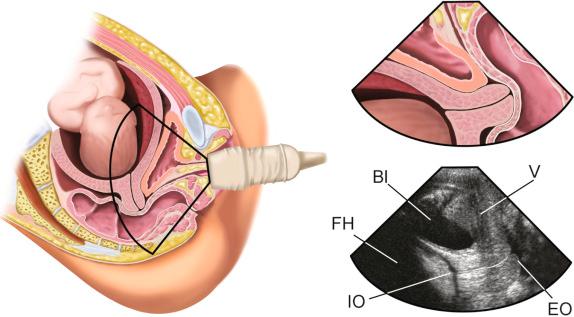
The first studies of the human cervix using TVU date back to the late 1980s. A clean transvaginal probe covered by a condom is gently inserted into the vagina ( Fig. 18-2A and B ). The technique shares the advantages of TLU; however, the probe is close to the cervix, without the problem of obscuring bowel gas. Thus, TVU has become the preferred approach for sonographic evaluation of the gravid cervix in virtually all clinical settings ( Fig. 18-3A to C ). Current recommendations for the performance of TVU of the cervix are shown in Table 18-2 .
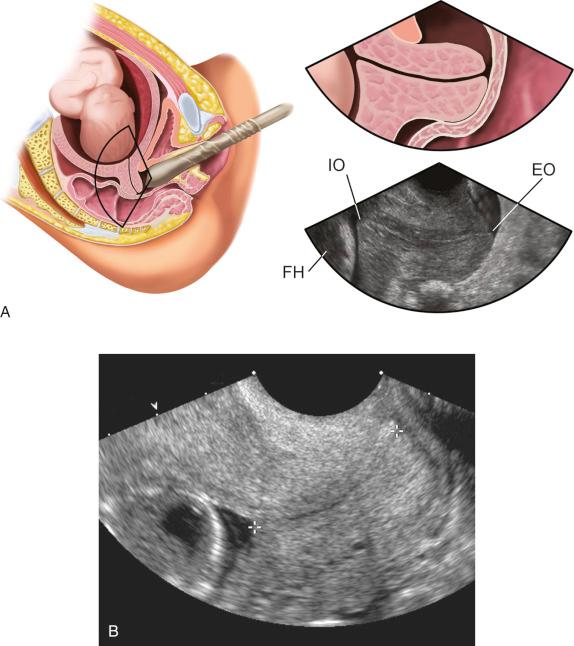
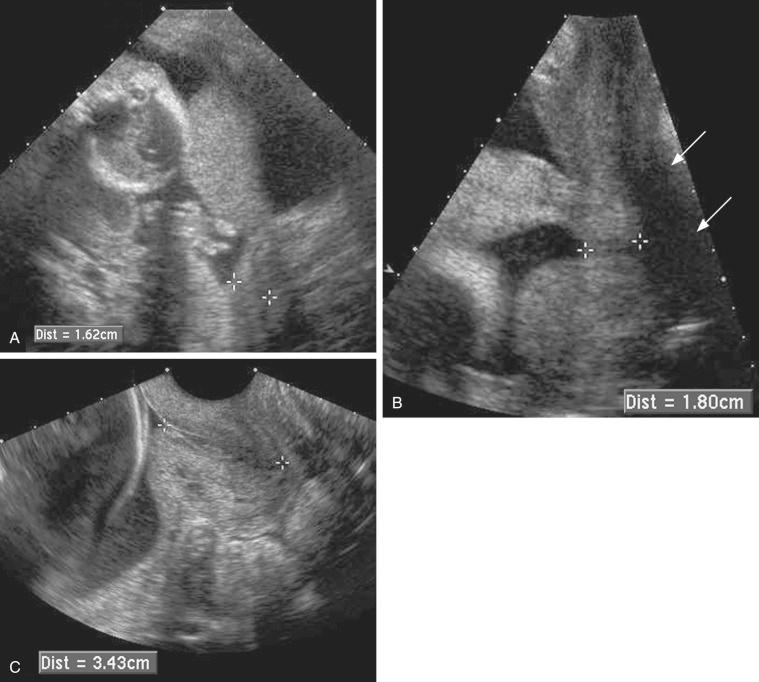
|
The total time for TVU of the cervix is approximately 5 minutes. For optimal results, the following criteria should be sought: the internal os should be either flat or at an isosceles angle with respect to the uterus, the whole length of the cervix should be visualized, a symmetric image of the external os should be obtained, the distance from the surface of the posterior lip to the cervical canal should be equal to the distance from the surface of the anterior lip to the cervical canal, and there should be no increased echogenicity in the cervix (a sign of excessive pressure).
Successful completion of the education program, examination, and continuing image review, all provided by the Perinatal Quality Foundation of the SMFM, is available and is recommended. Ideally, TVU CL assessment should only be performed after this program has been completed.
Although TVU of the cervix is usually straightforward, an anatomic or technical difficulty is encountered in approximately one fourth of patients.
A bladder that is not completely empty of urine can exert pressure on and appear to elongate the cervix or might mask funneling or opening of the internal os.
Excessive pressure by the examiner with the transvaginal transducer can also mask funneling or opening of the internal os and can elongate the cervix. This can be recognized by alterations in appearance including asymmetry in thickness of the anterior and posterior walls of the cervical canal and by increased echogenicity of the cervix ( Fig. 18-4 ).
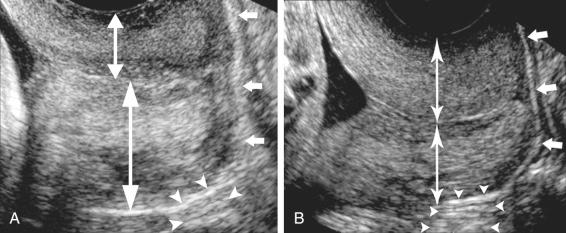
Uterine segment contractions may mimic the appearance of funneling of the internal cervical os. In such cases, there is rounded myometrium around the cervix and a normal cervix distal to the contraction ( Fig. 18-5 ).
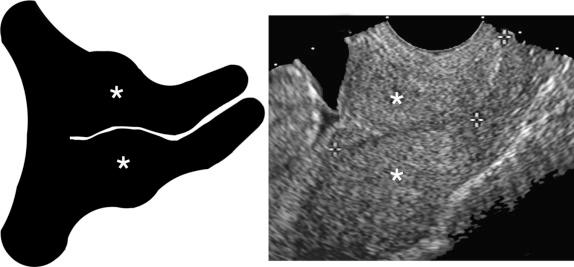
Before 14 weeks, the lower uterine segment is difficult to distinguish from the endocervical canal, because the gestational sac has not reached a sufficient size to completely expand the lower part of the uterus. Therefore, the measurement of the true CL is difficult before 14 weeks. At other times, particularly between 14 and 18 weeks' gestation, the presence of a contraction can close the lower uterine segment and make the distinction between this structure and the true CL difficult.
TVU of the cervix is most often used in obstetrics as a screening test for the prediction of PTB. To be clinically beneficial, a screening test must fulfill specific criteria ( Table 18-3 ).
| Characteristic of Screening Test | Comments |
|---|---|
| Disease | |
| Disease is clinically important | PTB: 1 million deaths annually worldwide |
| Disease is clearly defined | Birth < 37weeks |
| Disease prevalence is well known | 11.5% in United States; about 10% worldwide |
| Disease natural history is known; recognizable early asymptomatic phase | First cervical changes occur at the internal os |
| Screening | |
| Screening technique well described | Several articles |
| Screening is safe and acceptable | RCT on PPROM showing safety ; 99% would have it again; <2% experience severe pain |
| Screening has a reasonable cutoff identified | 20 mm is the 5th percentile, 25 mm is the 10% percentile in the general U.S. population |
| Results are reproducible (reliable) | <10% intraobserver and interobserver variability |
| Results are accurate (valid) | Better than manual examination; predictive in all populations studied (hundreds of studies) |
| Intervention, Cost-Effectiveness, and Feasibility | |
| “Early” intervention is effective | Two RCTs for vaginal progesterone ; five RCTs for cerclage |
| Screening and treating abnormal findings is cost-effective | Two cost-effectiveness manuscripts published |
| Facilities for screening are readily available | All pregnancies are offered a sonogram for fetal anatomy screening at around 18-24 weeks |
| Facilities for treatment are readily available | Vaginal progesterone is easily administered on an outpatient basis |
First, a good screening test must evaluate for a clinically important and prevalent condition. PTB occurs in 11.5% of births, or approximately 500,000 pregnancies, per year in the United States alone. It is the leading cause of perinatal morbidity and fatality in the United States and as such may be the most important pathologic condition in obstetrics. In terms of years of life lost, PTB is one of the most important diseases in all of medicine.
The technique is well described (see Table 18-2 ).
Become a Clinical Tree membership for Full access and enjoy Unlimited articles
If you are a member. Log in here